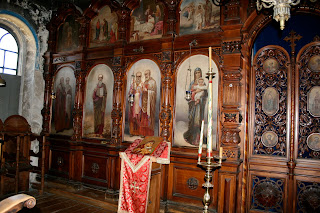The chapel of the the Athonias Ecclesiastical Academy (Athoniada) was built in 1901 on the edge of a building wing which served as the guest wing of the Skete of St. Andrew (Sarai). It is ornately decorated with imperial Russian icons, chandeliers and other various items. Its templon is carved wood which is quite beautiful and is adorned with classical Imperial Russian style icons. Its walls are fully painted with classical style paintings with various religious scenes and images of Saints.
The chapel is dedicated to the Three Hierarchs (St. Basil the Great, St. Gregory the Theologian, St. John Chrysostom) patron saints of Theological and Ecclesiatical students and studies.
I spent an enormous amount of time in this chapel as well as my fellow co-students. Three times a day every single day of the school calendar for Orthros, Esperino (Vespers) and Apodipno. This is we were learned to chant Byzantine music, learnt the typicon of the church, and served as chapel caretakers on a rotating roster.
The below photos I took of the chapel in 2008.
Iconostasis to the left of the entrance to the chapel.
Entrance to the chapel.
Some amazing chanters started at this psaltiri, Geron Meletios Sykeotis, Christos Halkias, Andreas Papadimopoulos, Rafael Smalios, Lazaros Tsetos, Timothy Diwema to name a few.



















































